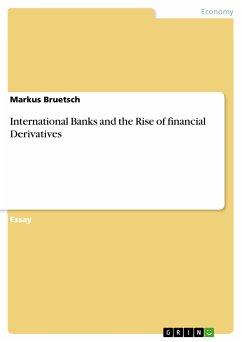Essay from the year 2003 in the subject Business economics - Banking, Stock Exchanges, Insurance, Accounting, grade: 1,9 (B+), Oxford Brookes University (Business School), course: Practise of International Banking, language: English, abstract: Derivatives trading is now the world's biggest business, with an estimated daily turnover of over US$2.5 trillion and an annual growth rate of around 14 per cent (Swan, 1999). Derivatives markets have ancient origins, and a long and complex history of trading and regulation. This work examines the history of derivatives and their impacts on the structure of international banks in order to show the implications of modern international banking in comparison to domestic banking. Mishkin (2003) describes banks as financial institutions that accept deposits and grant loans. In this definition banks are the financial intermediaries that the average person contacts most frequently for its financial dispositions, savings, investments and payments. The structure of a bank therefore seems to be adjusted to the purpose of its business activity. Mishkins traditional definition of a bank includes to those financial institutions we refer to as mutual savings banks, savings and loan associations, commercial banks and credit unions. Their traditional core business is to provide the settlement of national payments and to transform funds from savers over time as well as to process market information (Canals, 1997). They focus on domestic or regional, eventually even local markets and realize their profits from interest margins and balance sheet activities. Therefore they employ an asset- and liability management in order to avoid liquidity and credit risks.









